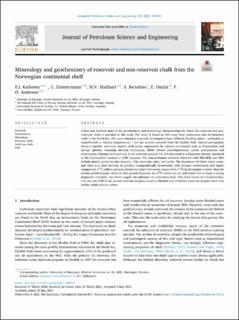| dc.contributor.author | Kallesten, Emanuela Iedidia | |
| dc.contributor.author | Zimmermann, Udo | |
| dc.contributor.author | Madland, Merete Vadla | |
| dc.contributor.author | Bertolino, Silvana R.A. | |
| dc.contributor.author | Omdal, Edvard | |
| dc.contributor.author | Andersen, Pål Østebø | |
| dc.date.accessioned | 2021-08-15T19:03:00Z | |
| dc.date.available | 2021-08-15T19:03:00Z | |
| dc.date.created | 2021-05-03T15:02:57Z | |
| dc.date.issued | 2021-05 | |
| dc.identifier.citation | Kallesten, E.I., Zimmerman, U., Madland, M.V. et al. (2021) Mineralogy and geochemistry of reservoir and non-reservoir chalk from the Norwegian continental shelf. Journal of Petroleum Science and Engineering, 205, 108914 | en_US |
| dc.identifier.issn | 0920-4105 | |
| dc.identifier.uri | https://hdl.handle.net/11250/2767848 | |
| dc.description.abstract | A first and detailed study of the geochemistry and mineralogy characterizing the North Sea reservoir and non-reservoir chalk is provided in this work. The study is based on 185 cores from exploration and development wells in the North Sea. The cores related to reservoir development have different flooding status – unflooded or waterflooded at various temperatures – and are directly sampled from the Ekofisk field. Optical petrography shows a micritic carbonate matrix, with grains represented by various microfossils such as foraminifers and sponge spicules. Scanning electron microscopy (SEM) reveals post-depositional calcite precipitation and cementation. Dolomite is found only in the reservoir samples, but it is discussed as a diagenetic feature, unrelated to the hydrocarbon content or EOR exposure. The non-carbonate minerals observed with BSE-SEM and XRD include mostly quartz but also smectite, illite, kaolinite, mica, and pyrite. The abundance of clastic input varies, and there is a clear decrease in porosity stratigraphically downwards, with stronger cementation and higher compaction. δ13C reflects primary trends for Upper Cretaceous stages while δ18O in all samples is lower than the secular global isotopic values for this period. However, the δ18O values are not sufficiently low to imply a strong diagenetic overprint, but rather suggest the influence of a secondary fluid. This fluid cannot be a hydrocarbon-rich one, nor EOR fluids, as non-reservoir samples, as well as flooded and unflooded reservoir samples show very similar stable isotope values. | en_US |
| dc.language.iso | eng | en_US |
| dc.publisher | Elsevier Ltd. | en_US |
| dc.rights | Navngivelse 4.0 Internasjonal | * |
| dc.rights.uri | http://creativecommons.org/licenses/by/4.0/deed.no | * |
| dc.subject | petroleumsteknologi | en_US |
| dc.subject | EOR | en_US |
| dc.title | Mineralogy and geochemistry of reservoir and non-reservoir chalk from the Norwegian continental shelf | en_US |
| dc.type | Peer reviewed | en_US |
| dc.type | Journal article | en_US |
| dc.description.version | publishedVersion | en_US |
| dc.rights.holder | © 2021 The Author(s). | en_US |
| dc.subject.nsi | VDP::Teknologi: 500::Berg‑ og petroleumsfag: 510::Petroleumsteknologi: 512 | en_US |
| dc.source.volume | 205 | en_US |
| dc.source.journal | Journal of Petroleum Science and Engineering | en_US |
| dc.identifier.doi | 10.1016/j.petrol.2021.108914 | |
| dc.identifier.cristin | 1907819 | |
| dc.relation.project | Norges forskningsråd: 230303 | en_US |
| dc.source.articlenumber | 108914 | en_US |
| cristin.ispublished | true | |
| cristin.fulltext | original | |
| cristin.qualitycode | 2 | |

